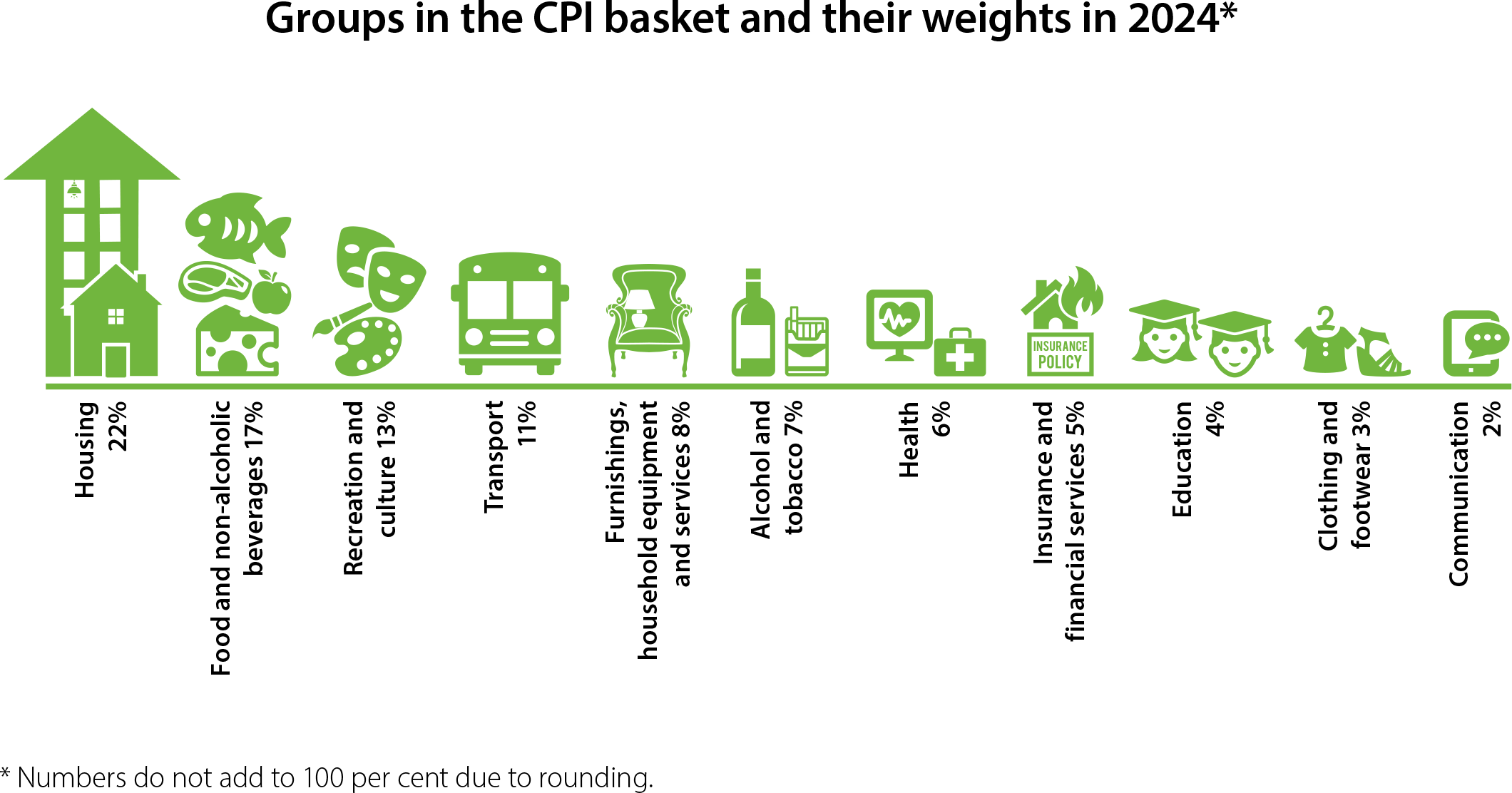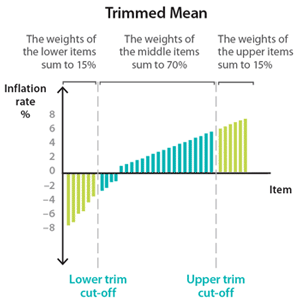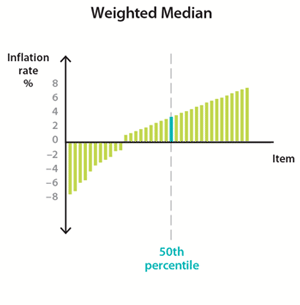Inflation Is Best Described As
Aggrandizement and its Measurement
Download the complete Explainer 169KBHow is Inflation Measured?
Inflation is an increase in the level of prices of the goods and services that households buy. It is measured every bit the rate of alter of those prices. Typically, prices rise over fourth dimension, but prices tin can likewise fall (a situation called deflation).
The most well-known indicator of inflation is the Consumer Toll Index (CPI), which measures the percentage alter in the price of a handbasket of appurtenances and services consumed by households.
In Commonwealth of australia, the CPI is calculated past the Australian Bureau of Statistics (ABS) and published once a quarter. To summate the CPI, the ABS collects prices for thousands of items, which are grouped into 87 categories (or expenditure classes) and eleven groups. Every quarter, the ABS calculates the toll changes of each item from the previous quarter and aggregates them to work out the inflation rate for the entire CPI basket.

Box: Calculating Inflation – An Example
To better understand how inflation is calculated we tin use an example. In this example we calculate inflation for a basket that has two items in it – books and childcare. The formula for calculating inflation for a single item is below.

The price of a book was $20 in 2016 (year one) and the price increased to $20.l in 2017 (year 2). The price of an hour of childcare was $30 in 2016, and this increased to $31.41 in 2017.
| Items | 2016 | 2017 | Inflation |
|---|---|---|---|
| | $twenty | $xx.fifty | two.v% |
| | $30 | $31.41 | iv.7% |
Using the formula, inflation for each of the individual items can be calculated.
- For books, almanac aggrandizement was 2.5 per cent
- For childcare, almanac inflation was 4.7 per cent
To calculate inflation for a basket that includes books and childcare, nosotros demand to employ the CPI weights that are based on how much households spend on these items. Because households spend more on childcare than books, childcare has a greater weight in the basket. In this instance, childcare accounts for 73 per cent of the basket and books account for the remaining 27 per cent. Using these weights, and the change in prices of the items, annual inflation for this basket was iv.i per cent – calculated as (0.73 x 4.seven) + (0.27 x 2.5).
How Are Prices Collected?
The ABS collects prices from a wide range of sources, such as retailers, supermarkets, department stores and websites where households shop. It besides collects prices from government government, energy providers and real estate agents. For some items, the ABS has access to information that allows it to tape prices frequently. For example, scanner data from supermarkets give information about the price and number of items a consumer buys in one transaction. For other items, the ABS records prices either monthly, quarterly or annually. In full, the ABS collects effectually 100,000 prices each quarter.
How Is the CPI Basket Chosen?
In deciding which goods and services to include in the CPI basket and what their weights should be, the ABS uses data most how much – and on what – households in Commonwealth of australia spend their income. If households spend more than of their income on i particular, that item volition have a larger weight in the CPI. For instance, the ABS included smart phones in the CPI to reverberate consumers taking advantage of advances in technology. Data on household spending across all items is only available approximately every five years or so.
Underlying Aggrandizement
While Australia's inflation target is expressed in terms of CPI inflation – known as 'headline aggrandizement' – it can also be useful to wait at indicators of 'underlying' aggrandizement. These indicators exclude items that have especially big price changes (either frequently or in a given quarter). Large price changes can oft be due to temporary factors, which are sometimes unrelated to broad conditions in the economy. For example:
- Supply disruptions because of unusual weather: For instance, in 2006 Tropical Cyclone Larry destroyed assistant crops in Queensland. As a event of this meaning reduction in supply, the price of bananas temporarily increased by 400 per cent.
- Infrequent changes in revenue enhancement regulations: For example, the introduction of the 10 per cent appurtenances and services tax (GST) in mid 2000 acquired the prices of many items to increase (the Reserve Bank typically shows headline CPI inflation excluding the effects of these revenue enhancement changes).
In contrast, price changes for a broad range of items may signal a shift in economic conditions. The Reserve Bank may make up one's mind to reply to this by changing involvement rates (meet Explainer: Australia's Inflation Target). In Australia, the most important indicators of underlying inflation are the trimmed mean and the weighted median (see Box: Computing the Trimmed Mean and the Weighted Median).
The ABS also calculates the CPI excluding volatile items, which is the boilerplate aggrandizement rate of all items in the CPI basket except for fruit, vegetables and fuel. Prices of fruit, vegetables and fuel are usually very volatile because they are oftentimes afflicted by supply disruptions, such every bit unusual weather, or changes in how much oil is supplied to the world market. The CPI excluding volatile items e'er removes the same items, while the items that are removed from the trimmed mean and weighted median tin change each quarter, depending on which items had particularly large price changes.

Box: Calculating the Trimmed Hateful and the Weighted Median
To calculate the trimmed mean and the weighted median, all 87 items are ordered by their quarterly, seasonally adapted price change. (Seasonal adjustment ways that price changes have been adapted for increases or decreases that ever occur at a item time of twelvemonth; for example, high school fees typically increase in the March quarter, and then an adjustment is made to spread this out over the year.)
Trimmed mean is the boilerplate rate of inflation after 'trimming' away the items with the largest price changes (positive or negative). It is the weighted average of the middle 70 per cent of items.

Weighted median is the inflation charge per unit of the item at the centre of the price changes in the CPI basket (the 50th percentile by weight).

Limitations of the CPI
CPI is not an indicator of the price level
The CPI measures the rate of price changes in the economic system, only not the price level. If the toll index of breadstuff is 140 and the price index of eggs is 180, it does not mean that eggs are more expensive than bread. It simply means that the price of eggs has increased past more than the price of bread from a detail point in time.
Coverage
For applied reasons, the CPI measures cost changes of items in the metropolitan areas of Commonwealth of australia's viii capital cities (where around twothirds of Australian households live). It does non mensurate cost changes in regional, rural or remote areas. The CPI too does not take into account the differences in spending patterns between individual households. Households are very different and some may spend a lot more on a certain items than others. For example, cars have a weight of nigh 3 per cent in the CPI handbasket, but not every household owns a car.
Quality changes
The CPI intends to just calculate pure toll changes. This means the CPI should ignore price changes that result from variations in the quality of items. The quality of items in the basket can vary and new products can be introduced. For instance, a bag of pasta can get smaller in weight, or the quality of a mobile phone can better if its camera is upgraded.
The ABS tries to remove whatever cost changes that result from changes in quality or the mix of items that households buy. Continuing with the previous examples, the ABS would calculate the price of the pasta bold that the weight remained the aforementioned, and compare it with the price in the previous quarter. Computing the increase in the price of a mobile telephone due to the improved camera is more difficult, because there is often limited information about how much the price of the phone has inverse because of the ameliorate camera. In this instance, the ABS would need to gauge the toll touch of the improved camera and adjust the mobile telephone price. Because the adjustment is only an guess, it tin can consequence in under or overestimation of the pure price change. Services are peculiarly difficult to quality-arrange considering changes ofttimes occur slowly and it is hard to measure past how much the service has improved. For case, better x-ray applied science at a infirmary could better notice injuries, but it is difficult to calculate how much the improvement in detecting injuries is worth. In those cases, it tin atomic number 82 to quality being only partly accounted for or not at all.
Substitution bias
The CPI is affected past 'substitution bias'. This is because the CPI does not adjust for changes in household spending patterns very often (every bit identifying such changes for all households is a major undertaking). In reality, households frequently modify the amounts they spend on items. For case, if lamb prices ascent past more than beef prices, households might accommodate and buy more beef and less lamb. Not bookkeeping for this type of substitution in expenditure results in besides much weight existence given to lamb in the CPI basket and besides little weight given to beef. This increases (or biases) the CPI compared with an index that accounts for households substituting from relatively more expensive items to relatively cheaper ones. In the by, updates to the CPI basket have taken place every 5 or vi years, and from tardily 2017 onwards, the ABS started updating the CPI weights on an annual basis, which will aid reduce the substitution bias in the CPI.
New products
The CPI does not include new products as soon as they appear on the market. Information technology can often take some time until the ABS includes them in the CPI handbasket. This typically occurs once a product has reached a high enough market share and is bachelor to most households.
Cost of living
The CPI is often used to mensurate changes in the toll of living, but it is not an ideal indicator of this. While the CPI measures price changes, toll-of-living inflation is the modify in spending by households required to maintain a given standard of living. The ABS publishes other indexes that aim to provide a better indicator of the cost of living.
Inflation Is Best Described As,
Source: https://www.rba.gov.au/education/resources/explainers/inflation-and-its-measurement.html#:~:text=Inflation%20is%20an%20increase%20in,(a%20situation%20called%20deflation).
Posted by: rosastichich.blogspot.com


0 Response to "Inflation Is Best Described As"
Post a Comment